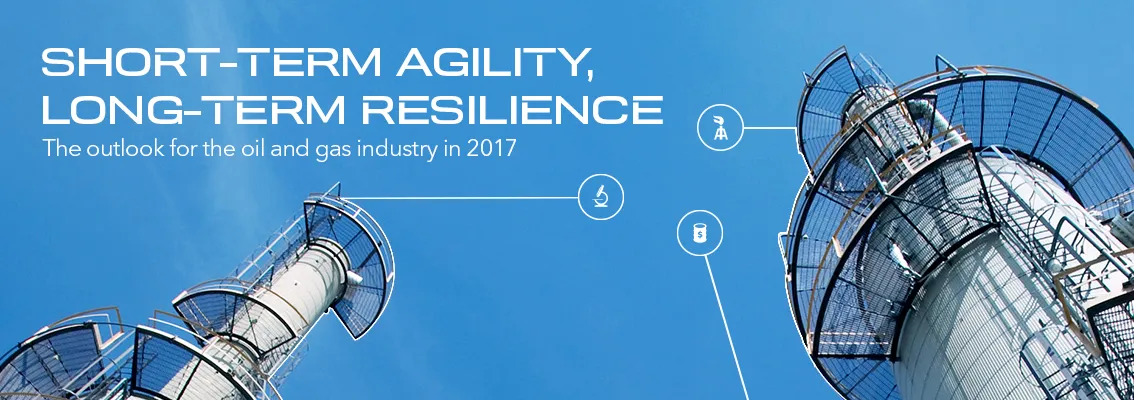Houston, TX: Despite the drawn-out recovery, confidence in oil and gas industry prosperity has risen over the past year among its US-based senior professionals — this according to new research by DNV GL. 45% of the US respondents feel confident in the industry’s prospects for the year ahead, compared with only 27% at the start of 2016.
Short-term agility, long-term resilience is DNV GL’s seventh annual benchmark study on the outlook for the oil and gas industry. The report provides a snapshot of industry confidence, priorities, and concerns for the year ahead. The study draws on a survey of 723 senior sector players1 globally.
Throughout the US market, respondents report that investments are spread across the value chain with 42% saying they are likely to invest in upstream, 45% in midstream, and 27% in downstream for 2017. Notably, 73% believe gas will become an increasingly important component of the global energy mix over the next 10 years.
Peter Bjerager, executive vice president, director of division Americas in DNV GL - Oil & Gas, commented: “We see the US oil and gas sector pushing opportunities and investments across the value chain. This shows the market’s ability to adapt and build a more robust portfolio as they position operations for the future. Our research echoes this and predicts a more positive outlook for the US market in the year ahead.”
Over the past couple of years, there has been a strong focus on the price of oil in relation to recovery. The study shows that 45% of US respondents expect the average WTI/Brent oil price to be in the range of $60-70/barrel, and 14% expect the price to be above $70/barrel, aligned with global expectations.
A more stable oil price would improve conditions for investing in oil and gas. “We are pleased to see that respondents globally consider the United States and Brazil to be the top country to invest in for 2017,” commented Bjerager.
Throughout the downturn DNV GL’s division Americas has invested resources in delivering solutions that optimize efficiency across the value chain. US respondents indicate a strong focus on both digitalization and subsea as emerging technologies in 2017.
Despite the optimism for 2017, cost management is still reported as a high priority among 82% of respondents (down 4% from 2016) and comparable with 85% globally. However, hard work paid off in 2016 and 79% of US respondents feel that they successfully achieved cost efficiency targets. Throughout the US, the key cost-cutting priorities for 2017 include OPEX (34%) and organization restructuring (33%); these are aligned with the global picture.
“In the last two years, we saw intense short-term cost-cutting measures throughout the industry,” adds Peter Bjerager. “Though US respondents have a stronger belief that the worst of the downturn is over, restructuring and reorganization are still on the table to ensure growth and competitiveness for the long-run.”
Other key findings:
- US respondents believe stronger oil prices will start to rebound in 2017 (41% versus 34% globally).
- US respondents (43%) see oversupply of oil and gas as a barrier to industry growth compared with 27% of sector professionals globally.
- The grip on cost control has loosened and dropped significantly from 65% in 2016 to 44%.
- The share of respondents expecting an increased focus on efficiency of assets and extending the lifespan of assets has increased significantly since last year. The share expecting increased focus on efficiency of assets in operations has risen from 34% to 41% while for life extension the percentage has grown from 29% to 36%. Both are slightly lower than the global response of 47% and 39% respectively for 2017.
- Expectations for increased overall headcount remain stable at 14%.
- The focus on cost management as a top priority in 2017 has seen a marked drop, from 38% to 23%. This is a larger fall than globally (from 41% to 34%).
- While OPEX and organizational restructuring are the top key priorities in both the US and globally in 2017, there is less of a focus on collaboration and supply chain savings in the US.
- 59% stated that cost pressures are driving companies to collaborate with industry participants.
- 68% understood that their business will seek to achieve greater standardization of tools and processes during 2017 – two percentage points higher than globally.
1.The outlook for the oil and gas industry in 2017 is an industry benchmark study from DNV GL, the leading technical advisor to the industry. Now in its seventh year, the programme builds on the findings of six prior annual outlook reports, first launched in early 2011. During October and November 2016, we surveyed 723 senior professionals and executives across the global oil and gas industry, along with 14 in-depth interviews with a range of experts, business leaders and analysts. Two–thirds (66%) are employed by suppliers and service companies across the industry, while 26% of respondents work for oil and gas operators. The remaining respondents come from regulators and trade associations. The companies surveyed vary in size: 41% had annual revenue of USD500m or less, while 18% had annual revenue in excess of USD5bn. Respondents were drawn from right across the oil and gas value chain, including publicly-listed companies and privately-held firms. They also represent a range of functions within the industry, from board-level executives to senior engineers.
